RBP4 Human ELISA
RBP4 (Retinol binding protein 4) belongs to the lipocalin family of proteins that transport small hydrophobic molecules. It encodes a protein of 201 amino acids and has a molecular mass of 21 kDa. 20–40% of RBP4 is expressed in the liver. In adipose tissue, RBP4 is expressed in mature, lipid-laden adipocytes. RBP4 is a transport protein for retinol (vitamin A) in the circulation and its levels correlate with retinol levels. RBP4 forms also a complex with transthyretin –a carrier of thyroid hormone and retinol which prevents glomerular filtration of RBP4 and its subsequent excretion through the kidney. Circulating RBP4 levels are also influenced by iron and ferritin status. RBP4 binds to cell surface receptors or through retinoic acid on retinoic acid receptors and retinoic acid-X receptors. A cell surface receptor stimulated by retinoic acid gene homolog 6 (STRA6) seems to be a major mediator of intracellular retinol uptake.
Serum RBP4 levels are increased and positively correlated with body mass index (BMI) and visceral fat, waist circumference and waist-to-hip-ratio in obese nondiabetic and diabetic subjects.
Serum RBP4 levels are increased in subjects with impaired glucose tolerance, T2D, and correlate inversely with insulin sensitivity in non-diabetic subjects with a family history of T2D. Circulating RBP4 levels correlate with the degree of insulin resistance in these subjects and relationship is independent of obesity. A decrease in serum RBP4 levels achieved by exercise training predicts the improvement in insulin sensitivity with greater specificity than leptin, adiponectin, interleukin-6, or C-reactive protein. Circulating RBP4 levels also correlate with other components of the metabolic syndrome. RBP4 is a predictor of atherosclerosis.
RBP4 levels are positively associated with intima media thickness, cerebral infarction, earlier cardiovascular disease, and increased risk of incident coronary disease. However, the positive association with the metabolic syndrome and its complications was not observed in all studies, and RBP4 level has not shown any additive value to the commonly accepted risk factors predicting the risk of future coronary artery disease. Increased circulating RBP4 levels in T2D subjects could be the result of decreased renal clearance of RBP4 caused by different levels of renal insufficiency in these subjects. Patients with end-stage kidney failure have significantly higher circulating RBP4 levels than healthy controls and that serum creatinine levels independently predict RBP4 concentrations in both controls and patients with kidney failure. Transthyretin could influence circulating RBP4 levels via RBP4’s decreased renal clearance. Imbalance between RBP4 and retinol might be the underlying cause for the observed association between RBP4 levels and systemic insulin resistance.
RBP4 is unexpectedly downregulated by tumor necrosis factor a (TNFa). An upregulation of RBP4 was found with the use of PPARg agonists troglitazone and pioglitazone. Lactoferrin, an iron donor, led to significantly increased expression of RBP4 and to increased release of RBP4 into the media in a dose-dependant manner. Apotransferrin and deferoxamine, both iron buffers, significantly decreased the expression and release of RBP4, suggesting a link between RBP4, insulin resistance, and iron metabolism.
The RAG005R Human Human RBP4 ELISA is a sandwich enzyme immunoassay for the quantitative measurement of human RBP4.
This assay is a competitive Enzyme Linked-Immunosorbent Assay (ELISA) for quantitative determination of human RBP4 in biological fluids. A polyclonal antibody recognizing native human RBP4 reacts with a series of predetermined recombinant human RBP4 standard proteins or samples under competition in the human RBP4-coated plate. Their relative reactivity is plotted with that of the standard proteins.
Intended use
Clinical Application
Test principle
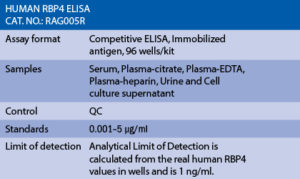
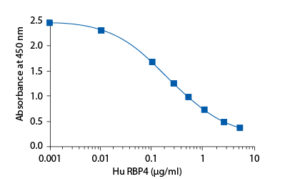
Precision
Intra-assay (Within-Run) (n=4) Five samples of known concentrations of human RBP4 were assayed in replicates 4 times to test precision within an assay.
Intra-assay (Within-Run) (n=4) Five samples of known concentrations of human RBP4 were assayed in 4 separate assays to test precision between assays.
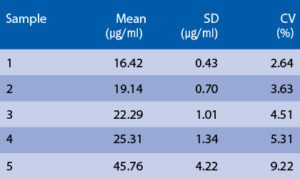
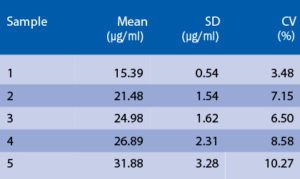
Different human serum samples containing RBP4 were compared with plasma samples. Different human serum samples containing RBP4 were diluted several fold (1/100 to 1/800) and the measured recoveries ranged from 81% to 110%.
Comparison of serum samples with plasma samples

Linearity
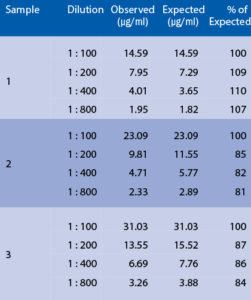
Summary of protocol
– Polyzos SA, Kountouras J, Anastasilakis AD, Geladari EV, Mantzoros CS. Irisin in patients with nonalcoholic fatty liver disease. Metabolism. 2014 Feb;63 (2):207-17

